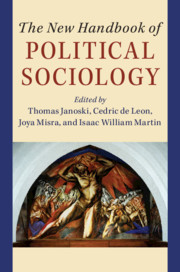Book contents
- The New Handbook of Political Sociology
- The New Handbook of Political Sociology
- Copyright page
- Dedication
- Contents
- Tables
- Figures
- Contributors
- Acknowledgments
- Introduction
- I Theories of Political Sociology
- 1 Power
- 2 Conflict Theories in Political Sociology
- 3 The Promise of Field Theory for the Study of Political Institutions
- 4 Culture in Politics and Politics in Culture
- 5 Political Sociology and the Postcolonial Perspective
- 6 Gender, State, and Citizenships
- 7 Theories of Race, Ethnicity, and the Racial State
- 8 Toward the Convergence of Culture and Political Economy?
- 9 Tasks for the Political Sociology of the Next Ten Years
- II Media Explosion, Knowledge as Power, and Demographic Reversals
- III The State and Its Political Organizations
- IV Civil Society: The Roots and Processes of Political Action
- V Established and New State Policies and Innovations
- VI Globalization and New and Bigger Sources of Power and Resistance
- Index
- References
2 - Conflict Theories in Political Sociology
Class, Power, Inequality, and the Historical Transition to Financialization
from I - Theories of Political Sociology
Published online by Cambridge University Press: 22 February 2020
- The New Handbook of Political Sociology
- The New Handbook of Political Sociology
- Copyright page
- Dedication
- Contents
- Tables
- Figures
- Contributors
- Acknowledgments
- Introduction
- I Theories of Political Sociology
- 1 Power
- 2 Conflict Theories in Political Sociology
- 3 The Promise of Field Theory for the Study of Political Institutions
- 4 Culture in Politics and Politics in Culture
- 5 Political Sociology and the Postcolonial Perspective
- 6 Gender, State, and Citizenships
- 7 Theories of Race, Ethnicity, and the Racial State
- 8 Toward the Convergence of Culture and Political Economy?
- 9 Tasks for the Political Sociology of the Next Ten Years
- II Media Explosion, Knowledge as Power, and Demographic Reversals
- III The State and Its Political Organizations
- IV Civil Society: The Roots and Processes of Political Action
- V Established and New State Policies and Innovations
- VI Globalization and New and Bigger Sources of Power and Resistance
- Index
- References
Summary
The social organization of capitalism in the twenty-first-century is radically different from in the middle decades of the twentieth century. Scholars from multiple disciplines and theoretical perspectives present this historical transition as a shift from a manufacturing to a finance-based economy. Although scholars from several disciplines examine dimensions of the transition to financialization, they tend to focus on outcomes and give limited attention to the political process of enacting policies and laws that made this transition possible. As a result, the transition to financialization is often assumed to be the outcome of an inevitable historical process moving toward economic equilibrium or the actions of an autonomous state. In contrast, conflict perspectives in political sociology focus on process and demonstrate how the emergent social structure is an outcome of conflict among different power holders.
Keywords
- Type
- Chapter
- Information
- The New Handbook of Political Sociology , pp. 53 - 78Publisher: Cambridge University PressPrint publication year: 2020
References
- 2
- Cited by

